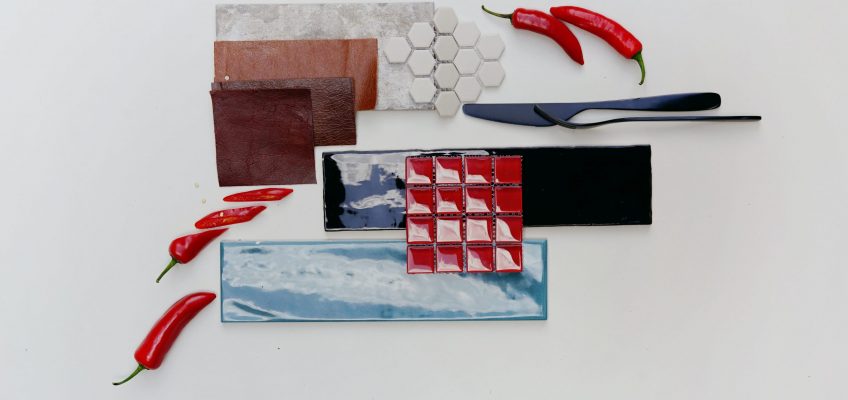It’s a debate that’s been going on for decades. And still, many home-owners aren’t sure about the difference between ceramic and porcelain tiles. Often, we rely on the help of salespeople with the required knowledge, but there’s a chance they sway us in a certain direction based on price. If you’re remodelling your home, or just redoing the floors in a few rooms, you should take the time to get to know ceramic vs porcelain tiles. They’re some of the most cost-effective, durable and practical floor coverings on the market, but there are distinct differences between the two. Here’s what you need to know about the difference between ceramic and porcelain tiles…
Ceramic vs porcelain tiles – what’s the difference?

Image by @thespruceofficial on Pinterest
Ceramic tiles
“Ceramic tiles are by far the most common tile currently on the market,” says Jasmin Kraneveldt from Bathroom Bizarre. One of the things that makes them so popular is that they’re affordable. And they’re available in a wide variety of colours and textures, some of which closely resemble expensive materials like natural stone, marble, travertine and wood. Ceramic tiles don’t require sealing or special maintenance, and they’re softer than porcelain tiles, making them easier to cut during the installation phase.
A drawback to ceramic tiles, however, is that one batch might contain tiles of slightly different sizes. This is because they’re cut and formed before firing, which leads to some tiles shrinking when they’re taken out of the oven. This size variation means you need to leave extra space for grouting between the tiles when you’re laying them, to accommodate the different sizes.
A criticism of ceramic tiles is that some aren’t hard enough for floor covering. They’re commonly used in wall applications. However, there are numerous ceramic tiles available that are appropriate for floor covering – just not in commercial or industrial settings. Their high porosity rate also makes ceramic tiles less frost-resistant than other options, so they’re not ideal in very cold climates.
ALSO SEE: 6 Tips For Surviving A Kitchen Remodel
Types of ceramic tiles
Glazed ceramic
Glazed ceramic tiles have a ceramic body with a thin layer of glaze/glassy material fired onto the surface. The glaze acts as waterproof protection and makes the tile chemical resistant, fire resistant and highly durable. Glazed ceramic tiles are available in a range of colours and textures, with finishes ranging from matt to gloss. They have a water absorption of over 0.5% and are suitable for domestic applications and in areas of high humidity like the bathroom, laundry or kitchen.
Unglazed ceramic (Terracotta)
The term Terracotta means “fired earth”, which makes sense when you think of the earthy tones of Terracotta tiles, ranging from red and ochre to brown. These tiles are made of fired clay and are not glazed. Because of the natural material, unglazed ceramic tiles vary in colour so no two tiles are the same. This gives them an authentic, rustic look. These tiles are suitable for internal and external environments but, because they’re fairly absorbent, the do tend to soak up liquids, stains or grease. Terracotta tiles, therefore, need to be sealed with a surface or penetrative sealant before they’re installed.
ALSO SEE: 7 Common Renovation Mistakes – And How To Avoid Them
Ceramic tiles are best for:
Cost. Ceramic tiles are generally more affordable.
Installation. Because ceramic tiles are slightly softer, they’re easier to cut to size in the installation process. This makes them a better option for rooms with odd dimensions.
Porcelain tiles
Unlike ceramic tiles, porcelain tiles are cut to size after the firing and production process is complete. This means that each porcelain tile in a specific batch has exactly the same measurements. Jasmin Kraneveldt says, “the beauty of standardised sizes is that when you are laying porcelain tiles, you can employ a minimal grouting line, measuring anywhere between 2mm and 3mm in width, for a truly streamlined and contemporary aesthetic.” This makes them popular in modern or minimalist homes.
ALSO SEE: How To Master The Spanish-Style Interior Design Trend In 2021
Types of porcelain tiles
Polished porcelain tiles
To give polished porcelain tiles that high-gloss sheen, the tiles go through a rigorous polishing process. This is done using soluble salts, after firing, and leaves the surface of the tile super smooth. The polishing also helps with slip resistance, which is unusual in such glossy tiles.
Unfortunately, because of rigorous polishing, the inner core of the tile is left exposed, which means it might be susceptible to staining. To avoid the tiles absorbing stains, make sure they’re sealed with a special sealer to protect the exposed clay pores. Because polished porcelain tiles are made entirely of clay, their colour spectrum is quite limited. They’re normally available in neutral shades of cream, beige, ivory and light grey.
Glazed porcelain tiles
While glazed porcelain tiles do have a certain sheen, the purpose of glazing is to protect the tiles with an extremely hardy surface. Glazed porcelain tiles can be polished mechanically if you want a really glassy finish, or semi-polished to help with sheen and non-slip durability. Because the glaze is so hardy and dense, the surface becomes non-porous and there’s no need for additional sealing. These tiles are resistant to everything from stains and scratches to frost. And they’re easy to keep clean. They also come in loads of colours and textures, with the option to print specific patterns on the tile.
The only downside? Glazed porcelain tiles are more expensive than glazed ceramic tiles. Their hardiness also makes them quite challenging to install.
ALSO SEE: Transform Your Small Space With This One Interior Design Tip
Full-bodied porcelain
The most noticeable feature of full-bodied porcelain tiles is that their colours and patterns run through the tile, rather than only being printed on the surface, so they’re very forgiving of slight chips. Like their other porcelain friends, they’re durable and come in loads of colours. They’re ideal for outdoor settings, given their frost- and slip-resistant qualities. But, because they’re unglazed and unpolished, they still need to be sealed. And, like other porcelain tiles, their hardiness makes them tough to cut and install.
Porcelain tiles are best for:
Water and heat resistance. Porcelain has slightly better water resistance, making it possible to use it in outdoor locations in regions with mild climates.
Durability and maintenance. As a harder material that has solid colour throughout, porcelain tiles are stronger and more durable. Chips are harder to spot.
Both ceramic and porcelain tiles have similar cleaning and care requirements, and they have a similar lifespan. In these categories, they come in tied.
ALSO SEE: 7 Budget-Friendly Ways To Luxe Up Your Bathroom
So now you know the main differences between ceramic and porcelain tiles. The next time you’re looking for new flooring for your home, we hope you find exactly the right option for your budget, function and aesthetic. If you need help in any part of a renovation process, we’d be happy to offer our expertise. Don’t hesitate to contact us for design solutions or renovation services.








Leave a Reply